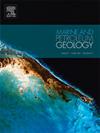Recognition and impact on reservoir quality of fractures in fine-grained sedimentary rocks using image and array acoustic logs
IF 3.7
2区 地球科学
Q1 GEOSCIENCES, MULTIDISCIPLINARY
引用次数: 0
Abstract
Fine-grained sedimentary rocks have been widely regarded as effective reservoirs and source rocks of tight oil and shale oil. Natural fractures play a critical role in promoting oil enrichment and enhancing production. Clarifying the contribution of fractures to reservoir quality is important but lacks systematic research. Limitations exist in both core outcrop descriptions and seismic predictions of fractures. New technological advancements in well logs offer new avenues for multi-scale fracture characterization. Image logs and array acoustic logs are used to systematically investigate natural fractures in the Member 7 of Upper Triassic Yanchang Formation (Chang 7) shale oil reservoirs in the Ordos Basin. Natural fractures include tectonic fractures and bedding-parallel fractures. An absolute match between core data and image log data is achieved through the precise core homing. The reliability of image logs is enhanced by establishing the fracture identification templates under the core scale. The Vp/Vs ratio, energy attenuation, waveform distortion, and S-wave slowness anisotropy of array acoustic logs are effective for detecting and predicting natural fractures around the borehole. The impact of natural fractures on reservoir quality is evaluated by considering fracture parameters, radial extension and their relationship with in-situ stress. The results show that combining the occurrence and type of fractures detected by image logs and the fracture extension state indicated by fast and slow S-wave radial variations, the effectiveness of fractures around the wellbore can be accurately evaluated. T1-T2 maps from 2D NMR logs also offer insights into the relationship between fractures and reservoir quality. Natural fractures that are nearly parallel to the direction of the in-situ SHmax have proven to be effective and significantly enhance hydrocarbon productivity. The research above may aid in optimizing sweet spot evaluation and stimulating shale oil production.
求助全文
约1分钟内获得全文
求助全文
来源期刊

Marine and Petroleum Geology
地学-地球科学综合
CiteScore
8.80
自引率
14.30%
发文量
475
审稿时长
63 days
期刊介绍:
Marine and Petroleum Geology is the pre-eminent international forum for the exchange of multidisciplinary concepts, interpretations and techniques for all concerned with marine and petroleum geology in industry, government and academia. Rapid bimonthly publication allows early communications of papers or short communications to the geoscience community.
Marine and Petroleum Geology is essential reading for geologists, geophysicists and explorationists in industry, government and academia working in the following areas: marine geology; basin analysis and evaluation; organic geochemistry; reserve/resource estimation; seismic stratigraphy; thermal models of basic evolution; sedimentary geology; continental margins; geophysical interpretation; structural geology/tectonics; formation evaluation techniques; well logging.
 求助内容:
求助内容: 应助结果提醒方式:
应助结果提醒方式:


